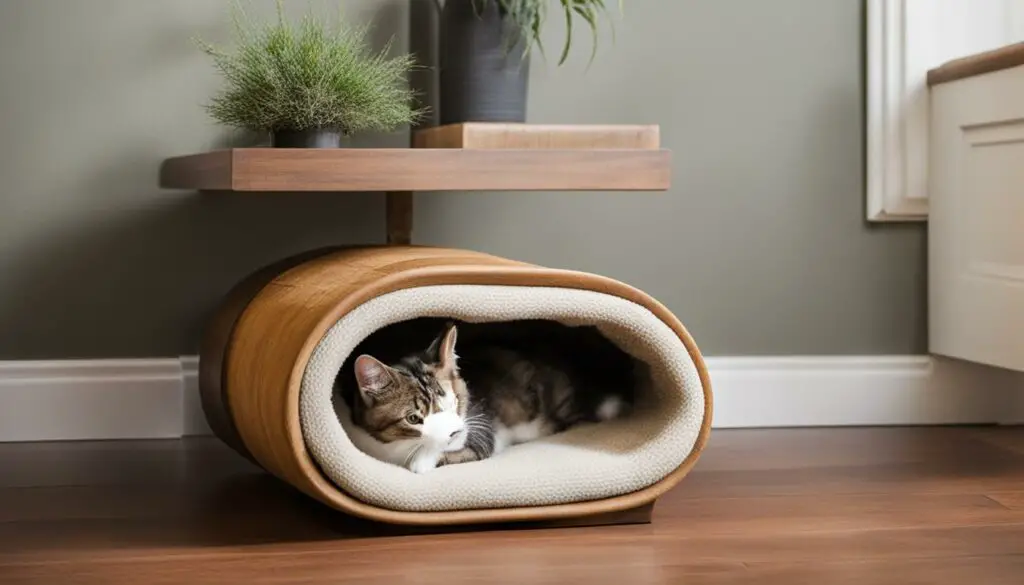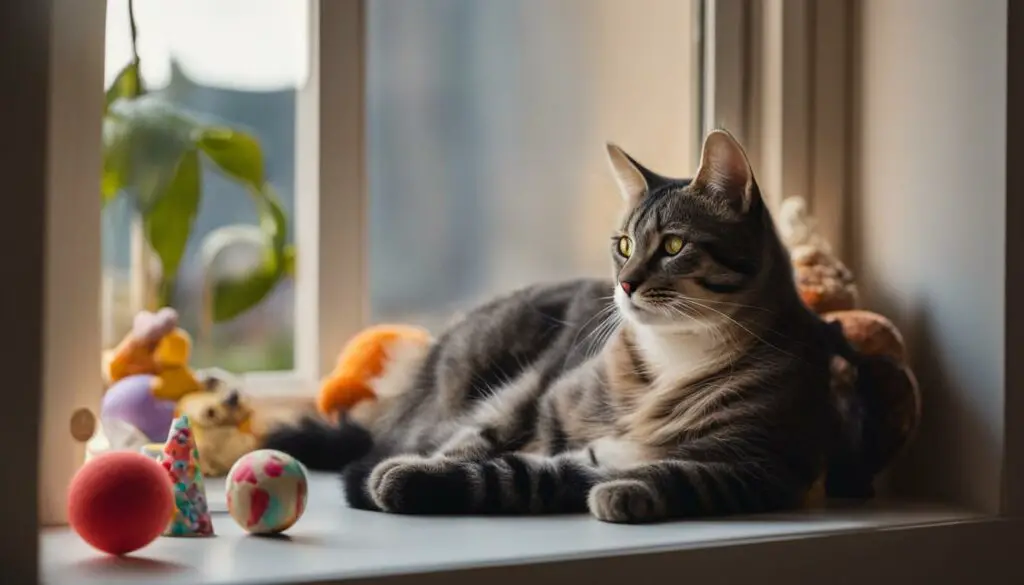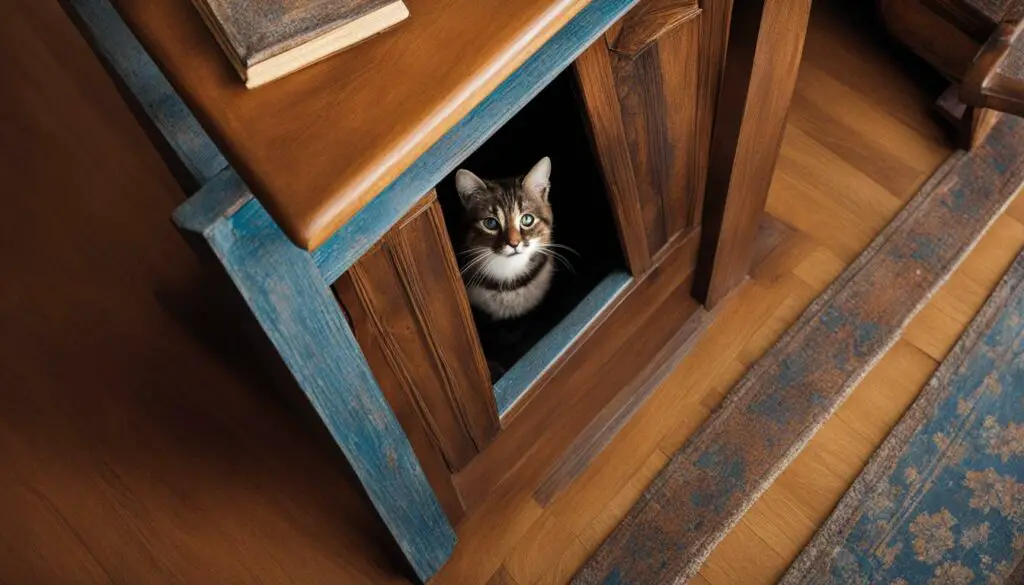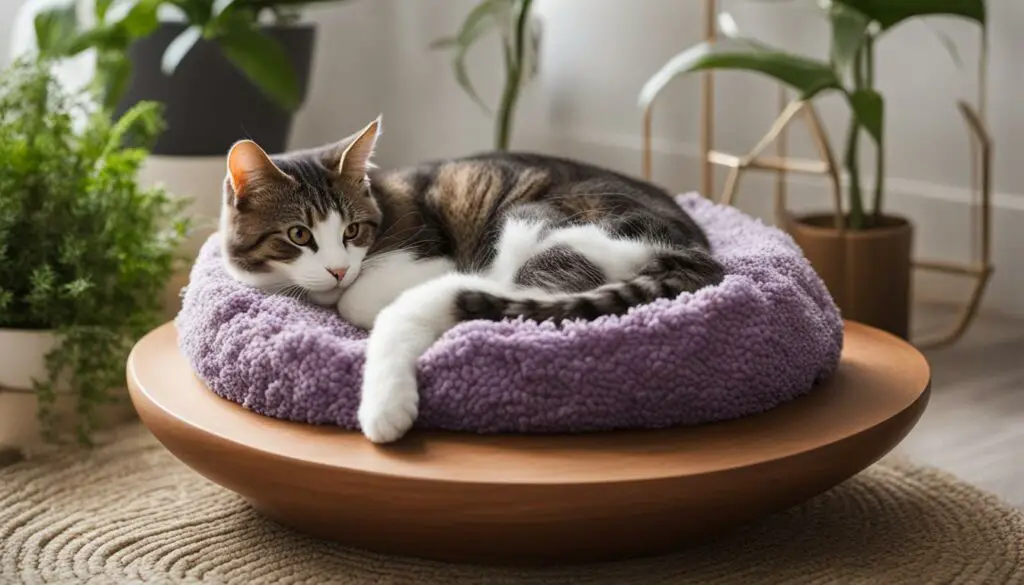Have you ever wondered why your cat becomes so terrified whenever a stranger comes into your home? It’s a common behavior in many feline friends, and there are several reasons behind their fear. From lack of exposure to timid personality traits, understanding the root causes can help you alleviate your cat’s anxiety and help them feel more comfortable around strangers.
One of the leading causes of this fear is often a lack of exposure to different people during their kittenhood. If your cat hasn’t been socialized with a variety of individuals, they may perceive unfamiliar faces as a threat. Additionally, some cats are naturally more timid than others, which can contribute to their fear of strangers. Loud noises that often accompany visitors, such as laughter or loud talking, can also increase their anxiety.
It’s crucial to rule out any underlying medical reasons for sudden behavioral changes in your cat. If you notice any abnormal or extreme fear reactions, it’s always a good idea to consult with your veterinarian to ensure your cat’s physical well-being.
There are effective strategies you can implement to help your cat feel more comfortable around strangers. By gradually exposing them to new people, using positive reinforcement techniques, and creating a safe space for them to retreat to, you can help alleviate their anxiety and build trust in unfamiliar situations.
Key Takeaways:
- Cats can be scared of strangers due to lack of exposure during their kittenhood.
- Some cats have naturally timid personalities, contributing to their fear of unfamiliar individuals.
- Loud noises can increase a cat’s anxiety and fear of strangers.
- Gradual exposure to new people, positive reinforcement, and creating a safe space can help cats feel more comfortable around strangers.
- Patience and understanding are essential when helping a fearful cat overcome their fear.
Lack of Exposure to Different People
When it comes to cats being scared of strangers, one of the possible reasons is a lack of exposure to different people during their kittenhood. Just like humans, cats need socialization to feel comfortable and confident around unfamiliar faces. Kittens who haven’t had much interaction with people outside of their immediate family may develop fear and anxiety when encountering strangers.
During the critical period of kittenhood, it’s important to expose them to a variety of people, including individuals of different ages, sizes, ethnicities, and genders. This helps them become accustomed to different appearances and behaviors, reducing the likelihood of fear later on. Positive reinforcement is essential during this process, rewarding kittens for calm and friendly interactions with strangers.
To illustrate the importance of socialization, let’s take a look at the following table:
| Types of People Exposed to During Kittenhood | Resulting Comfort Level with Strangers |
|---|---|
| Various ages, sizes, ethnicities, and genders | High comfort level |
| Limited exposure to a specific group of people | Moderate comfort level |
| Minimal exposure to people outside of immediate family | Low comfort level |
Table: Impact of Different Types of Exposure on Cat’s Comfort Level with Strangers
As shown in the table, cats who have been exposed to a diverse range of people during their early development are more likely to feel at ease with strangers compared to those with limited or minimal exposure. Socializing kittens is a crucial step in helping them become well-adjusted, confident cats who can navigate interactions with unfamiliar individuals smoothly.

While lack of exposure to different people can contribute to a cat’s fear of strangers, it’s never too late to start working on socialization. With patience, positive reinforcement, and gradual introductions, even the most shy and fearful cats can learn to feel more comfortable around unfamiliar faces.
Timid Personality Traits
Some cats are naturally more timid and fearful than others. These cats may exhibit anxiety and fear when faced with strangers or unfamiliar situations. Understanding and addressing their timid personality traits can help reduce their fear and anxiety, allowing them to feel more comfortable and secure.
Reducing fear in timid cats requires a gradual approach and positive reinforcement. It’s important to create a safe and calm environment for them, where they can feel in control and protected. Building trust with these cats takes time and patience, as forcing them into uncomfortable situations can worsen their anxiety.
One effective approach is to use rewards to encourage calm behavior in the presence of strangers. For example, when a visitor comes over, provide treats or toys as a positive reinforcement when the cat remains calm. This helps the cat associate strangers with positive experiences, gradually reducing their fear over time.
“By providing timid cats with a safe and secure environment, using positive reinforcement, and allowing them to set the pace of interactions, we can help them overcome their fears and build trust,” says Dr. Emily Thompson, a feline behavior specialist.
It’s important to remember that some cats may never feel completely comfortable with physical interaction with strangers. Respecting their boundaries and providing them with a safe space where they can retreat to if needed is crucial. By understanding and addressing their timid personality traits, we can help these cats lead happier and more confident lives.

Section 4: Loud Noises and Anxiety
Loud noises can be a significant source of anxiety for cats when it comes to strangers visiting their home. The sudden presence of visitors often brings along sounds like laughter, loud talking, and movement, which can intensify a cat’s fear and contribute to their overall anxiety. It’s important for cat owners to understand that these noises can be overwhelming for their feline companions and may result in behavior changes such as hiding, aggression, or excessive grooming.

To address this issue, it is crucial to create a calm and quiet environment for cats during visits. Minimizing loud noises and ensuring a peaceful atmosphere can help reduce their anxiety levels. It’s also essential to rule out any underlying medical conditions that may be causing sudden behavior changes in cats. If a cat’s fear and anxiety persist even after creating a calm environment, consulting a veterinarian is recommended to address any potential health issues.
By gradually exposing cats to visitors and providing positive experiences, it is possible to help them overcome their fear of strangers. This can be achieved through rewards and treats, encouraging calm behavior in the presence of visitors. Over time, cats can learn to associate the presence of strangers with positive experiences, helping to reduce their anxiety and build trust.
Gradual Approach and Rewards
When helping a skittish adult cat feel comfortable around strangers, a gradual approach and rewards are essential. It is important to introduce the cat to unfamiliar people slowly and in a controlled manner, allowing the cat to feel safe and in control of the situation. One effective method is to have a trusted friend play the role of a visitor, starting from a distance and gradually getting closer over several sessions. This gradual exposure allows the cat to associate positive experiences with the presence of a stranger.
During these interactions, rewards play a crucial role in reducing fear and increasing the cat’s comfort levels. Offering treats and toys can help create positive associations with strangers. By providing rewards for calm behavior and allowing the cat to approach the visitor on its own terms, the cat learns that being near a stranger can lead to enjoyable experiences.
In addition to rewards, it is important to provide a safe hiding space for the cat. This hiding space should be easily accessible, preferably in a room where the cat has already spent time and feels comfortable. This allows the cat to retreat to a familiar and secure area when feeling overwhelmed or scared. Respecting the cat’s need for privacy in this space is crucial to help reduce anxiety and build trust.
| Benefits of a Gradual Approach and Rewards |
|---|
| Helps the cat associate positive experiences with strangers |
| Allows the cat to feel safe and in control during interactions |
| Reduces fear and increases the cat’s comfort levels |
| Teaches the cat that being near a stranger can lead to enjoyable experiences |
Creating a Safe Space
When it comes to helping our cats feel more comfortable around strangers, creating a safe space is essential. Cats often rely on hiding as a coping mechanism when they feel scared or overwhelmed. By providing them with a designated hiding spot, we can give them a sense of security and control over their environment.
Respecting Cat’s Privacy
Cat hiding behavior is a natural instinct, and it’s important to respect their need for privacy. When guests are over, make sure they understand not to enter the cat’s hiding space or try to force interaction. Let the cat come out on their own terms, as this will help them build trust and gradually feel more at ease around strangers.
Additionally, consider placing the cat’s hiding spot in a quiet room where they feel safe and have access to necessities like food, water, and a litter box. This designated space will become their sanctuary and a place where they can retreat to when they need a break from social interaction.
| Hiding Spot Essentials | Why It’s Important |
|---|---|
| Comfortable bedding | Provides a cozy and familiar space for the cat |
| Height options (shelves, cat trees) | Allows the cat to observe visitors from a safe vantage point |
| Access to food, water, and litter box | Ensures the cat’s basic needs are met even while hiding |
| Quiet and secluded location | Reduces exposure to noise and creates a calming environment |
Remember, creating a safe space for your cat is crucial in helping them feel more comfortable around strangers. Respect their need for privacy, provide a designated hiding spot, and ensure they have access to all their necessities. With time and patience, your cat will gradually become more at ease and may even venture out to explore and interact with visitors on their own terms.

Restricting Access to Certain Areas
When it comes to helping cats feel more comfortable around guests, restricting their access to certain areas of the house can be an effective strategy. By limiting where visitors can go, you can create a safe and familiar environment for your cat, reducing their anxiety and fear of unfamiliar spaces.
Providing your cat with a sense of control is crucial in helping them feel at ease when strangers are present. By allowing them to freely explore the rest of the house while guests are confined to a specific area, you are giving your cat the opportunity to maintain their normal routine and engage with the environment on their terms.
Not only does restricting access to certain areas create a calm and secure space for your cat, but it also reduces the chances of unwanted interactions or accidental scares. This can help build trust between your cat and your guests, as your cat will feel more in control of the situation and less threatened by unfamiliar individuals.
Table: Comparing Restricted Access vs. Full Access
| Restricted Access | Full Access | |
|---|---|---|
| Cat Comfort | Provides a safe and familiar environment | Potential for increased stress and anxiety |
| Cat Behavior around Guests | More likely to be curious and observe from a distance | May hide or display defensive behaviors |
By implementing restrictions on guest access, you are prioritizing your cat’s comfort and well-being. This approach can help your cat gradually become more comfortable around strangers, leading to a more positive and relaxed experience for everyone involved.

Allowing Cats to Approach
Cats communicate a lot through their body language, and respecting their signals can help reduce fear and anxiety. When it comes to interacting with strangers, it’s best to let the cat take the lead and approach on their own terms. Approaching cats directly can be seen as threatening and trigger their fear response. By giving cats control over their interactions, we can help them feel more comfortable and gradually build trust.
When visitors are over, it’s important to encourage them to avoid making sudden movements or staring directly at the cat. Instead, guests should remain calm and seated, allowing the cat to approach when they feel ready. This approach gives the cat a sense of control and allows them to gauge the situation without feeling overwhelmed. By creating a low-pressure environment, we can help reduce fear and promote positive interactions.
Remember, every cat is unique, and some may take longer to feel comfortable approaching strangers. Patience is key in allowing them to build trust at their own pace. It’s important to recognize and respect their boundaries, as forcing interactions can worsen their fear. By giving them the time and space they need, we can help them overcome their fear and feel more secure in their environment.

Understanding Cat Body Language
Cats use various body signals to communicate their feelings. Here are a few common cues to look out for:
- Tail position: A relaxed, low tail suggests the cat is comfortable and at ease. A raised tail with a slight curve indicates curiosity and friendliness. A puffed-up tail or a tail tucked between the legs may indicate fear or anxiety.
- Ears: Forward-facing, relaxed ears indicate a calm and content cat. Flattened or backward-facing ears can signal fear or aggression.
- Eye contact: Dilated pupils and intense staring can indicate fear or anxiety. Blinking or slow blinking is a sign of trust and relaxation.
- Body posture: A relaxed, open posture with a slightly arched back indicates comfort and confidence. A hunched or crouched position may suggest fear or tension.
By paying attention to these cues, we can better understand how a cat is feeling and adjust our approach accordingly. Allowing cats to approach on their own terms will not only help them feel safer around strangers but also strengthen the bond between cats and their human companions.
Creating a Calming Environment
In order to help reduce cat anxiety and create a more comfortable environment when visitors are present, there are several strategies that can be implemented. By taking these steps, cat owners can help their feline companions feel more at ease and reduce their fear of strangers.
Minimizing Stressors
One of the first steps in creating a calming environment is to minimize stressors that may contribute to a cat’s anxiety. This includes reducing loud noises, sudden movements, and bright lights. By creating a peaceful atmosphere, cats are more likely to feel relaxed and comfortable.
“Cats are sensitive to their environment, and calming their surroundings can have a significant impact on their behavior and anxiety levels.” – Dr. Sarah Johnson, veterinarian
Providing Safe Spaces
Another important aspect of creating a calming environment is to provide safe spaces for cats to retreat to when they feel overwhelmed. This can be a designated room or area where the cat can hide, such as a cozy cat bed or a quiet corner with their favorite toys. Respecting the cat’s need for privacy and ensuring that guests understand not to invade their safe space is crucial.
Using Pheromone Diffusers
Pheromone diffusers, such as Feliway, can also be effective in creating a calming environment for cats. These diffusers release synthetic pheromones that mimic the natural calming scents that cats use to communicate. By placing these diffusers in areas where the cat spends the most time, such as their sleeping area or near their safe space, it can help reduce anxiety and create a sense of calm.

Creating a calming environment for a cat can greatly improve their comfort and reduce their anxiety when visitors are present. By minimizing stressors, providing safe spaces, and using pheromone diffusers, cat owners can help their feline friends feel more at ease in unfamiliar situations.
Patience and Time
When it comes to helping a fearful cat feel more comfortable around strangers, patience and time are key. Building trust and reducing fear cannot be rushed, and it’s essential to understand that every cat is unique and may require different amounts of time to adjust. It’s crucial to respect the cat’s boundaries and allow them to progress at their own pace.
During the process, it’s important not to force the cat to come out of hiding or interact with strangers before they are ready. This can intensify their fear and anxiety, making it even more challenging for them to trust others. Instead, provide a calm and secure environment for the cat, allowing them to observe visitors from a safe distance and approach when they feel comfortable.
In addition to giving the cat time and space, it’s essential to provide positive experiences during their interactions with strangers. Rewarding the cat with treats, praise, and play when they exhibit calm behavior can create positive associations and help them feel more at ease. By consistently reinforcing these positive experiences, the cat will begin to build trust and associate strangers with positive outcomes.
Remember, every cat is an individual, and some cats may never feel completely comfortable around strangers. It’s important to accept and respect their limitations. Provide a safe space for them to retreat to when visitors are present, and ensure that your guests understand and respect the cat’s boundaries. With patience, understanding, and consistent positive reinforcement, you can help a fearful cat overcome their fear and live a happier, more comfortable life.

Quotes:
“Building trust and reducing fear cannot be rushed, and it’s essential to understand that every cat is unique and may require different amounts of time to adjust.”
“During the process, it’s important not to force the cat to come out of hiding or interact with strangers before they are ready.”
Key Takeaways:
- Patience and time are crucial when helping a fearful cat feel more comfortable around strangers.
- Respect the cat’s boundaries and allow them to progress at their own pace.
- Provide a calm and secure environment for the cat and reward them with positive experiences during interactions with strangers.
- Accept and respect the cat’s limitations, providing a safe space for them to retreat to when visitors are present.
Using Food as a Bonding Tool
When it comes to building trust with cats and creating positive associations with people, one effective tool that can be utilized is food. Feeding cats at scheduled times instead of leaving food out all day can establish a routine and help cats associate mealtime with the presence of people. This can contribute to a more positive relationship and reduce fear and anxiety.
Sharing meals with cats can be a bonding experience that fosters trust and strengthens the human-cat relationship. Offering small, tasty treats during social interactions can help create positive associations with people. These treats can be used as rewards for calm behavior or as a way to initiate gentle physical contact, such as chin scratches or petting. By associating good things, like tasty food, with the presence of people, cats can start to feel more comfortable and safe around strangers.
Additionally, providing interactive feeding toys or puzzle feeders can engage cats‘ natural hunting instincts and provide mental stimulation. This not only helps cats feel more content and fulfilled, but it can also create positive associations with their surroundings and the presence of people. Interactive feeding toys can be used during social interactions, encouraging cats to approach and interact with visitors while enjoying their meals, further strengthening the bond between cats and people.
| Tips for Using Food to Build Trust |
|---|
| 1. Establish a consistent feeding schedule. |
| 2. Use small, tasty treats as rewards for calm behavior. |
| 3. Share mealtimes with cats to foster trust. |
| 4. Incorporate interactive feeding toys for mental stimulation. |
Remember, building trust with cats takes time and patience. It’s important to allow cats to approach and interact with people at their own pace, never forcing physical contact or overwhelming them with too much too soon. By using food as a bonding tool and creating positive associations, cats can gradually learn to feel more comfortable and secure around strangers, enhancing their overall well-being and quality of life.

Providing a High Viewpoint
Cats are naturally curious creatures, and they often feel more comfortable when they can observe their surroundings from a higher spot. Providing a high viewpoint for your cat can help create a sense of security and reduce their anxiety when visitors are present. Cats can retreat to these elevated areas if they feel overwhelmed and observe the visitors from a safe distance.
There are various options for creating a high viewpoint for your cat. Installing shelves on the walls, placing a cat tree in the room, or providing a cat bed on top of furniture can all serve as elevated spots for your cat to perch on. These elevated areas should be strategically placed in the room so that your cat can observe visitors without feeling threatened.
By offering a high viewpoint for your cat, you are giving them the opportunity to feel more in control of the situation. Cats have a natural instinct to seek higher ground when they feel insecure, and providing them with this option can help them feel more at ease during interactions with strangers.

Benefits of a High Viewpoint for Cats
- Reduced anxiety: Being in a high position allows cats to feel more secure and in control of their surroundings.
- Observation without direct interaction: Cats can observe visitors from a safe distance without feeling the need to interact directly, which can help them feel more comfortable.
- Escape route: Cats can retreat to their elevated spot if they feel overwhelmed or need some alone time, providing them with a sense of security.
- Reduced stress: Having a high viewpoint can help cats feel less stressed during visits from strangers, as they have a safe space to retreat to when needed.
Creating a high viewpoint for your cat is a simple yet effective way to promote their comfort and well-being when visitors are present. By giving them the option to observe from above, you are providing them with a sense of security and control in unfamiliar situations.
Using Calming Odor
Cats are known for their sensitive noses and their ability to pick up on scents that humans may not even notice. This heightened sense of smell can be a source of comfort or anxiety for cats, depending on the situation. When it comes to reducing fear and anxiety in cats, one effective method is to use calming odors.
Calming odor products, such as Feliway, imitate the natural pheromones that cats release when they feel safe and secure. These products can help create a calming environment and reduce anxiety in cats, making them feel more at ease around strangers. By spraying these products around the house before visitors arrive, the cat can experience a sense of familiarity and relaxation, which can help alleviate their fear.

In addition to creating a calm atmosphere, calming odors can also help to establish positive associations with strangers. When cats encounter the calming odor while in the presence of visitors, they may begin to associate the scent with feelings of safety and comfort. Over time, this can help the cat build trust and reduce their fear of strangers.
It’s important to note that while calming odor products can be helpful for many cats, they may not be effective for all individuals. Each cat is unique, and what works for one may not work for another. It’s always a good idea to monitor your cat’s behavior and consult with a veterinarian if you have concerns about their anxiety or fear.
Conclusion
In conclusion, understanding why your cat is so scared of strangers is crucial in helping them feel more comfortable and secure. Cats may exhibit fear and anxiety due to various reasons, such as lack of exposure to different people during their kittenhood, timid personality traits, and loud noises that accompany visitors.
To assist your cat in overcoming their fear, it’s important to rule out any medical reasons for their behavioral changes and gradually help them feel more at ease around strangers. Positive reinforcement, creating a safe space, and a gradual approach can all contribute to reducing fear and building trust with your fearful cat.
Remember, every cat is unique, and some may never feel completely comfortable with physical interaction with strangers. Patience and understanding are key in allowing your cat to set their own pace and helping them lead happier, more confident lives.
FAQ
Why is my cat so scared of strangers?
Cats may be scared of strangers due to lack of exposure, timid personality traits, or loud noises that accompany visitors. It’s important to understand the reasons behind their fear in order to help them feel more comfortable.
How can lack of exposure to different people affect my cat’s behavior?
Lack of exposure during kittenhood can lead to fear and anxiety around unfamiliar faces. Socialization with people of different ages, sizes, and genders during their early stages of life is important in helping cats feel comfortable around a variety of people.
What can I do to help my timid cat feel less fearful around strangers?
Building trust and reducing fear in timid cats requires a gradual approach, rewards for staying calm in the presence of strangers, and positive reinforcement. Understanding and respecting their boundaries is crucial in helping them overcome their fear.
How do loud noises contribute to my cat’s fear of strangers?
Cats can be sensitive to loud noises, and the noises that visitors bring along, such as laughing and loud talking, can increase a cat’s anxiety and contribute to their fear of strangers. Minimizing sudden movements and loud noises can help create a more peaceful environment for the cat.
How can I gradually help my cat feel more comfortable around strangers?
Helping a skittish cat requires a gradual approach and positive reinforcement. Having a friend play the part of a visitor, offering treats and toys, and allowing the cat to approach the visitor on its own terms can help reduce fear and increase comfort levels.
How can I create a safe space for my cat when strangers visit?
It’s important to provide a safe space for your cat to hide if they feel overwhelmed. This space should include necessary amenities like food, water, and a litter box, and guests should be informed to avoid entering the cat’s hiding space.
Should I restrict guests to a specific area of the house when my cat is scared of strangers?
Restricting guests to a specific area can make cats feel more comfortable. By limiting their presence, the cat can freely move around without feeling overwhelmed or threatened, reducing their fear of unfamiliar spaces.
Should I let strangers approach my scared cat?
It’s best to let the cat approach visitors on its own terms. Approaching cats can be seen as threatening and can escalate their fear. Allowing the cat to have control over their interactions can help them feel more at ease and build trust at their own pace.
How can I create a calming environment for my cat when visitors are present?
Creating a peaceful atmosphere is important. Guests should be seated and avoid staring directly at the cat, while sudden movements and loud noises should be minimized. Gradually decreasing the distance between the cat and the visitor, and offering treats and toys, can help build positive associations with strangers.
How long does it take to change a skittish cat’s behavior?
Changing a cat’s behavior takes time and patience. It’s important not to force them out of hiding or expect instant results. Some cats may never feel completely comfortable around strangers, and that’s okay. Building trust requires understanding and respecting their boundaries.
Can using food help my cat feel more comfortable around strangers?
Yes, using food as a bonding tool can help build positive associations with people and reduce fear and anxiety. Feeding cats at scheduled times creates a routine and associates mealtime with the presence of people, contributing to a more positive relationship.
Why do cats feel more comfortable observing visitors from a higher spot?
Cats feel more secure when observing strangers from a higher vantage point. Providing options for them to climb, such as shelves or cat trees, allows them to observe without feeling threatened and reduces their anxiety.
Can using products with calming odors help reduce my cat’s fear of strangers?
Yes, using products that emit soothing natural cat odors, like Feliway, can create a calming environment and reduce anxiety and fear. Spraying these products around the house before visitors arrive can help create a more relaxed atmosphere for the cat.
Source Links
- https://www.webmd.com/pets/cats/shy-fearful-cats
- https://www.hepper.com/why-is-my-cat-scared-of-strangers/
- https://www.vetstreet.com/our-pet-experts/how-can-i-teach-my-cat-to-be-less-fearful-of-strangers








